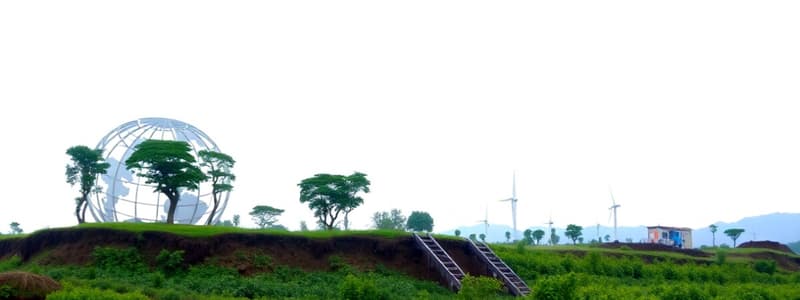Podcast
Questions and Answers
Wanem samting i respons blong ol piksa we i digramem?
Wanem samting i respons blong ol piksa we i digramem?
Ol piksa ia i tesem wanem fasin?
Ol piksa ia i tesem wanem fasin?
- Fasin blong lesin mo save. (correct)
- Fasin blong frenim ol pipol.
- Fasin blong wok long wan bea.
- Fasin blong storian wetem ol pikinini.
What type of information is primarily conveyed by the images presented?
What type of information is primarily conveyed by the images presented?
- Visual representation of concepts (correct)
- Historical events chronicle
- Statistical data analysis
- Textual narratives or stories
Which of the following best describes the overall purpose of the images?
Which of the following best describes the overall purpose of the images?
What aspect of the images can assist in understanding complex ideas?
What aspect of the images can assist in understanding complex ideas?
Which characteristic is least likely to be found in the images?
Which characteristic is least likely to be found in the images?
How do the images contribute to learning experiences?
How do the images contribute to learning experiences?
Which image most effectively illustrates the concept of interconnected systems?
Which image most effectively illustrates the concept of interconnected systems?
Which image is likely to emphasize cause and effect relationships?
Which image is likely to emphasize cause and effect relationships?
Which image best represents a conceptual framework?
Which image best represents a conceptual framework?
Which image might illustrate the impact of external influences on an internal system?
Which image might illustrate the impact of external influences on an internal system?
Which image would be least effective in demonstrating a dynamic process?
Which image would be least effective in demonstrating a dynamic process?
Which image is most likely to depict a causal relationship between elements in a system?
Which image is most likely to depict a causal relationship between elements in a system?
Which option best describes an image that illustrates a feedback loop?
Which option best describes an image that illustrates a feedback loop?
Which image is best suited to demonstrate the concept of adaptation in a system?
Which image is best suited to demonstrate the concept of adaptation in a system?
Which image is most likely to show a hierarchical structure?
Which image is most likely to show a hierarchical structure?
Which type of image would effectively showcase interactions within a network?
Which type of image would effectively showcase interactions within a network?
Which image most likely portrays the concept of synergy within a system?
Which image most likely portrays the concept of synergy within a system?
Which image is best designed to illustrate a complex system's feedback dynamics?
Which image is best designed to illustrate a complex system's feedback dynamics?
Which image most effectively shows the interplay between internal and external elements?
Which image most effectively shows the interplay between internal and external elements?
Which image is likely to depict a system undergoing adaptation over time?
Which image is likely to depict a system undergoing adaptation over time?
Which image is least likely to represent a system's hierarchical organization?
Which image is least likely to represent a system's hierarchical organization?
Which image is most likely to represent the concept of feedback mechanisms in a system?
Which image is most likely to represent the concept of feedback mechanisms in a system?
Which image would best illustrate the concept of an ecosystem with multiple interdependent elements?
Which image would best illustrate the concept of an ecosystem with multiple interdependent elements?
Which image is likely to convey the impact of external factors on a system's behavior?
Which image is likely to convey the impact of external factors on a system's behavior?
Which image is best suited to demonstrate the concept of adaptation within a system over time?
Which image is best suited to demonstrate the concept of adaptation within a system over time?
Which image most effectively shows the relationship between different elements in a dynamic process?
Which image most effectively shows the relationship between different elements in a dynamic process?
Flashcards
Importan olsem
Importan olsem
Samting oli kamaot long wan ples i go long naraples.
Eksport
Eksport
Samting blong wan kantri i go long naraples long bisnis.
Bisnis
Bisnis
I kamaot long ol samting man i mekem blong binim olgeta samting.
Prays
Prays
Signup and view all the flashcards
Suplai
Suplai
Signup and view all the flashcards
Supply and Demand
Supply and Demand
Signup and view all the flashcards
Pricing Strategies
Pricing Strategies
Signup and view all the flashcards
Market Equilibrium
Market Equilibrium
Signup and view all the flashcards
Economic Indicators
Economic Indicators
Signup and view all the flashcards
Market Structures
Market Structures
Signup and view all the flashcards
Supply
Supply
Signup and view all the flashcards
Demand
Demand
Signup and view all the flashcards
Equilibrium
Equilibrium
Signup and view all the flashcards
Price
Price
Signup and view all the flashcards
Market
Market
Signup and view all the flashcards
Supply
Supply
Signup and view all the flashcards
Demand
Demand
Signup and view all the flashcards
Price
Price
Signup and view all the flashcards
Market Equilibrium
Market Equilibrium
Signup and view all the flashcards
Economic Indicator
Economic Indicator
Signup and view all the flashcards
Supply and Demand
Supply and Demand
Signup and view all the flashcards
Market Equilibrium
Market Equilibrium
Signup and view all the flashcards
Economic Indicator
Economic Indicator
Signup and view all the flashcards
Price
Price
Signup and view all the flashcards
Market
Market
Signup and view all the flashcards
Supply
Supply
Signup and view all the flashcards
Demand
Demand
Signup and view all the flashcards
Price
Price
Signup and view all the flashcards
Market Equilibrium
Market Equilibrium
Signup and view all the flashcards
Economic Indicator
Economic Indicator
Signup and view all the flashcards
Study Notes
Environmental & Social Standards in Multilateral Financial Institutions & Safe Guard Policies of the World Bank
- Dis ples i ant longwan blong ol kantri blong help ol rae i stap fasin
- Ol i givim ol advaes na support long ol wok blong fasin i gohed
- Ol i help long ol plan blong fasin, na givim mani long ol i gohed
- Ol i gat olsem wan sistem blong karekim ol fesin na sosal
- Olsem ol i fasin long hem, ol i no save stap long ol taim i gat ol prublema
Module 1: Overview of the Course
- Ol Multilateral Financial Institutions (MFIs)
- Reason blong tekem wan fasin blong wok
- Wan nupela fasin blong save long fesin na sosial standad
- Ris na impak blong karekim olsemwan
- Olsim na diferens blong ol nupela fasin, olsem taem ol World Bank and ol narada bank i fasin i gohed
Session 1: Environmental & Social Standards in Multilateral Financial Institutions
- Wan explain blong MFIs, na givim 5 example
- 3 reason blong MFIs
- Reason blong tekem wan fasin blong environmental and sosial
- 2 reason blong wan nupela restructuring blong environmental and sosial standad
- Explain environmental and social risks, impacts and their coverage
- 2 potential environmental and social risks and impacts
- Similarities and differences among new safeguard standards
Session 1: Objectives
- Define Multilateral Financial Institutions (MFIs) using 5 examples.
- Mention 3 objectives that MFIs perform
- Explain the reasoning behind using an integrated approach to environmental and social safeguards.
- Provide two reasons for restructuring the Environment and Social Standards
- Explain environmental and social risks, impacts and coverage
- Mention two potential risks and impacts
- Compare and contrast various safeguard standards adopted by different Multilateral Financial Institutions (MFIs)
Lesson 1: Multilateral Financial Institutions
- Definition of Multilateral Financial Institutions (MFIs)
- MFIs play a major role in the social and economic development programs of nations.
- MFIs share some common goals and objectives
- MFIs were created to foster economic and social development
Examples of Multilateral Financial Institutions
- African Development Bank
- Asian Development Bank
- Caribbean Development Bank
- Inter-American Development Bank
- The World Bank
- European Bank for Reconstruction and Development
- Islamic Development Bank
Environment and Social Values
- Environmental Values: Air and water quality, Biodiversity, Landscape aesthetics, Spiritual value derived from nature, Natural resources, Ecosystem services
- Social Values: Human health, Property and belongings, Community integrity, Fairness and equity, Rights, Protections for the vulnerable
Rationale for the Harmonization of ES Safeguards
- Setting requirements for borrowers to undertake environmental and social assessments.
- A set of supplementary safeguards dealing with specific environmental and social risks.
- High degree of consistency in risk areas covered
Rationale for the Harmonization of ES Safeguards
- Greater impetus to harmonize environmental and social safeguards among development agencies
- Multilateral Development Banks (MDBs) established a working group to develop a common framework for environmental assessment
A New Approach and Common Objectives
- Safeguards should be integral to Sustainable Development Goals
- Address wider range of environmental and social risks
- Renew efforts to manage environmental and social risks with borrowers
- Improve policy harmonization, coherence and alignment with partners
- Enhance transparency by engaging stakeholders and sharing information
Lesson 2: Re-structuring of ESS among MFIs
- New MDB standards are compulsory
- Project classification incorporates environment, social and climate change
- New standards added, addressing labor and working conditions, community health and safety, vulnerability, disability, fragility.
RE-STRUCTURING OF ESS AMONG MFIs
- The new standards apply to the project and associated facilities.
- Pollution Management is now integrated into Resource Efficiency, Prevention and Management.
- Borrowers are now more responsible for monitoring, implementing, and reporting on environment and social requirements.
Risks and Impacts and their coverage
- Potential risks in investment projects, defined as the possibility of environmental or social value being lost or damaged.
- E&S impact is a realised risk, or a risk with 100% occurrence certainty.
Potential Risks & Impacts in the New ESS
- Human security threats
- Cultural heritage
- Community safety and worker health & safety
- Environmental impacts;
- Climate change
- Impacts on land use and tenure
- Biodiversity and natural habitats
Lesson 3: Overview of the New Safeguard Standards Adopted by the MFIs
- MFIs concentrate on providing financial and capacity building to developing nations.
- MFIs' priorities and resource allocation mechanisms evolve over time.
- MFIs have adopted diverse orientations and sectoral priorities.
Policy reform, institutional and capacity building
- MFIs have different methods of channeling resources
- Direct lending (to the public and private sector) and indirect lending (through financial intermediaries, public and private)
Indirect Lending through Financial Intermediaries
- Central Bank
- Financial Intermediaries
- Commercial Banks
- Saving & Loan Associations
- Insurance Companies
Similarities and Differences Between the New Safeguard Standards
- This section compares and contrasts the types of financing and borrowers for various MFIs.
Similarities and Differences Between the New Safeguard Standards Adopted by the MFIs
- This section shows the different financing types and types of borrowers for various MFIs.
Rationale for an Integrated Safeguard System (ISS)
- The AfDB concluded that its existing policies aren't suitable as an integrated set of safeguards.
- AfDB wants an integrated set of environmental and social safeguards that borrowers, AfDB officials, and external observers can easily understand.
Rationale for an ISS Contd.
- AfDB needed to develop an integrated system to build on its existing cross-cutting policies and environmental and social assessment procedures.
- Elements included in the system are safeguard policy, operational safeguards, and procedural guidance
Rationale for an ISS Contd.
- Needed to collate existing policies, adapt to MDB best practices, and provide a basis for operationalization.
- Aim to harmonize environmental and social safeguards with other multilateral development banks.
The Integrated Safeguard System (ISS)
- The system has components like Bank Policies (including cross-cutting aspects), Operational Safeguards, ESAP/Procedures, and Guidelines.
Objectives of the Operational Safeguards (OS)
- The objectives are to establish environmental and social requirements
- Strengthen the capacity of the Bank and borrowers/clients to integrate environmental and social considerations in operations
- Assist member countries to develop safeguard systems
- Prevent adverse effects on the environment and local communities
- Minimize, mitigate or compensate for unavoidable adverse effects
Objectives of the Operational Safeguards (OS) Contd
- Take into account climate change’s impact and projects' carbon emissions
- Establish roles and responsibilities for the bank, borrowers/clients, and local participation
- Promote harmonization of practices with other multilateral development banks
The Five Operational Safeguards (OS) of the ISS
- Environmental and Social Assessment (including Strategic Environmental and Social Assessment, Management Frameworks and procedures)
- Involuntary Resettlement (including land acquisition, displacement and compensation)
- Biodiversity and Ecosystem Services (including water resources management)
- Pollution Prevention and Control (including greenhouse gases, hazardous materials and resources efficiency)
- Labor Conditions, Health and Safety (including ILO standards)
Safeguards Range of Application [1/2] and [2/2]
- World Bank safeguards apply to investment lending, community driven development and social funds
Important Information
- Objective(s), Trigger(s), Instruments, Timing
- Consultation requirements, Disclosure requirements, and Translation requirements
Lesson 3: Environmental and Social Framework
- The ESF applies to all new World Bank investment projects (effective October 1, 2018).
- Addresses labour, non-discrimination, climate change mitigation, biodiversity, community health and safety, and stakeholder engagement.
Environmental and Social Framework
- Comprehensive environmental and social standards addressing risk and impact assessment, labor, resource efficiency, pollution, community/land use, involuntary resettlement, biodiversity, and cultural heritage.
- Stakeholder engagement, and information disclosure.
The WB ESF builds on the Safeguard policies
- This section gives details of how the Environmental and Social Framework builds on the World Bank Safeguard Policies from previous versions.
Categories of Projects
- Projects are classified into Category A, B, or C.
- Category A projects have significant adverse environmental impacts while Category C have minimal or no adverse impacts.
Studying That Suits You
Use AI to generate personalized quizzes and flashcards to suit your learning preferences.




